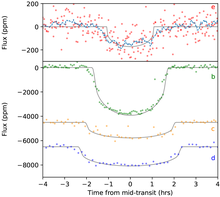K2-32
| Observation data Epoch J2000 Equinox J2000 | |
|---|---|
| Constellation | Ophiuchus[1] |
| Right ascension | 16h 49m 42.2602s[2] |
| Declination | −19° 32′ 34.151″[2] |
| Apparent magnitude (V) | 12.31±0.02[3] |
| Characteristics | |
| Spectral type | G9V[4] |
| Apparent magnitude (J) | 10.404±0.024[5] |
| Apparent magnitude (H) | 9.993±0.025[5] |
| Apparent magnitude (K) | 9.821±0.019[5] |
| Variable type | Planetary transit variable[6] |
| Astrometry | |
| Radial velocity (Rv) | −1.82±0.14[7] km/s |
| Proper motion (μ) | RA: −16.662(18)[2] mas/yr Dec.: −53.564(13)[2] mas/yr |
| Parallax (π) | 6.3939 ± 0.0153 mas[2] |
| Distance | 510 ± 1 ly (156.4 ± 0.4 pc) |
| Details[3] | |
| Mass | 0.856±0.028 M☉ |
| Radius | 0.845+0.044 −0.035 R☉ |
| Surface gravity (log g) | 4.49±0.05 cgs |
| Temperature | 5275±60 K |
| Metallicity [Fe/H] | −0.02±0.04 dex |
| Rotational velocity (v sin i) | 0.7 km/s |
| Age | 7.9±4.5 Gyr |
| Other designations | |
| Database references | |
| SIMBAD | data |
K2-32 is a G9-type main sequence star slightly smaller and less massive than the sun.[4] Four confirmed transiting exoplanets are known to orbit this star.[9] A study of atmospheric escape from the planet K2-32b caused by high-energy stellar irradiation indicates that the star has always been a very slow rotator.[10]
Planetary system
[edit]Discovery
[edit]The star K2-32 was initially found to have three transiting planet candidates by Andrew Vanderburg and collaborators in 2016.[7] The innermost planet candidate, at that time, K2-32b was confirmed using radial velocity measurements made with the Keck telescope.[4] Confirmation of planets c and d was made by Sinukoff et al. using adaptive optics imaging and computer analysis to eliminate possible false positives.[6]
The Earth-sized planet K2-32e was discovered and validated by René Heller and team in 2019.[9][11]

Characteristics
[edit]With periods of 4.34, 8.99, 20.66 and 31.71 days the four planets orbits are very close to a 1:2:5:7 orbital resonance chain. The densities of planets b, c, and d are between those of Saturn and Neptune, which suggests large and massive atmospheres. The planet K2-32e with a radius almost identical to that of the Earth is almost certainly a terrestrial planet.[9] All four planets are well inside even the optimistic inner boundary of the habitable zone located at 0.58 astronomical units.[12]

| Companion (in order from star) |
Mass | Semimajor axis (AU) |
Orbital period (days) |
Eccentricity | Inclination | Radius |
|---|---|---|---|---|---|---|
| K2-32e | 2.1+1.3 −1.1 M🜨 |
0.04899+0.00041 −0.00038 |
4.34934±0.00039 | 0.043+0.048 −0.030 |
89.0±0.7° | 1.212+0.052 −0.046 R🜨 |
| K2-32b | 15.0+1.8 −1.7 M🜨 |
0.07950+0.00066 −0.00062 |
8.992±0.00008 | 0.03+0.032 −0.02 |
89.0+0.5 −0.3° |
5.299±0.191 R🜨 |
| K2-32c | 8.1±2.4 M🜨 | 0.13843+0.00115 −0.00108 |
20.66093+0.00080 −0.00079 |
0.049+0.046 −0.035 |
89.4+0.3 −0.2° |
2.134+0.123 −0.102 R🜨 |
| K2-32d | 6.7±2.5 M🜨 | 0.18422+0.00152 −0.00144 |
31.71701+0.00101 −0.00096 |
0.05+0.053 −0.035 |
89.4±0.1° | 3.484+0.112 −0.129 R🜨 |
References
[edit]- ^ Roman, Nancy G. (1987). "Identification of a Constellation From a Position". Publications of the Astronomical Society of the Pacific. 99 (617): 695–699. Bibcode:1987PASP...99..695R. doi:10.1086/132034. Vizier query form
- ^ a b c d e Brown, A. G. A.; et al. (Gaia collaboration) (2021). "Gaia Early Data Release 3: Summary of the contents and survey properties". Astronomy & Astrophysics. 649: A1. arXiv:2012.01533. Bibcode:2021A&A...649A...1G. doi:10.1051/0004-6361/202039657. S2CID 227254300. (Erratum: doi:10.1051/0004-6361/202039657e). Gaia EDR3 record for this source at VizieR.
- ^ a b c Petigura, Erik A.; et al. (2017). "Four Sub-Saturns with Dissimilar Densities: Windows into Planetary Cores and Envelopes". The Astronomical Journal. 153 (4) 142. arXiv:1702.00013. Bibcode:2017AJ....153..142P. doi:10.3847/1538-3881/aa5ea5.
- ^ a b c Dai, Fei; et al. (2016). "Doppler Monitoring of Five K2 Transiting Planetary Systems". The Astrophysical Journal. 823 (2) 115. arXiv:1604.01413. Bibcode:2016ApJ...823..115D. doi:10.3847/0004-637X/823/2/115.
- ^ a b c Skrutskie, Michael F.; et al. (1 February 2006). "The Two Micron All Sky Survey (2MASS)". The Astronomical Journal. 131 (2): 1163–1183. Bibcode:2006AJ....131.1163S. doi:10.1086/498708. Vizier catalog entry
- ^ a b Sinukoff, Evan; et al. (2016). "Eleven Multiplanet Systems From K2 Campaigns 1 and 2 and the Masses of Two Hot Super-Earths". The Astrophysical Journal. 827 (1) 78. arXiv:1511.09213. Bibcode:2016ApJ...827...78S. doi:10.3847/0004-637X/827/1/78.
- ^ a b Vanderburg, Andrew; et al. (2016). "Planetary Candidates from the First Year of the K2 Mission". The Astrophysical Journal Supplement Series. 222 (1) 14. arXiv:1511.07820. Bibcode:2016ApJS..222...14V. doi:10.3847/0067-0049/222/1/14.
- ^ "K2-32". SIMBAD. Centre de données astronomiques de Strasbourg. Retrieved 2019-09-01.
- ^ a b c d e f Heller, René; Rodenbeck, Kai; Hippke, Michael (2019). "Transit least-squares survey. I. Discovery and validation of an Earth-sized planet in the four-planet system K2-32 near the 1:2:5:7 resonance". Astronomy and Astrophysics. 625 A31. arXiv:1904.00651. Bibcode:2019A&A...625A..31H. doi:10.1051/0004-6361/201935276.
- ^ Kubyshkina, D.; et al. (2019). "Close-in Sub-Neptunes Reveal the Past Rotation History of Their Host Stars: Atmospheric Evolution of Planets in the HD 3167 and K2-32 Planetary Systems". The Astrophysical Journal. 879 (1) 26. arXiv:1906.12153. Bibcode:2019ApJ...879...26K. doi:10.3847/1538-4357/ab1e42.
- ^ "Astronomers Discover 18 New Small Exoplanets in Kepler Data" (Press release). Sci-News.com. 2019-05-28. Retrieved 2019-09-27.
- ^ Wittenmyer, Robert A.; et al. (2018). "The K2-HERMES Survey. I. Planet-candidate Properties from K2 Campaigns 1–3". The Astronomical Journal. 155 (2) 84. arXiv:1712.06774. Bibcode:2018AJ....155...84W. doi:10.3847/1538-3881/aaa3e4.
- ^ Lillo-Box, J.; et al. (2020). "Masses for the seven planets in K2-32 and K2-233". Astronomy & Astrophysics. 640 A48. arXiv:2006.01102. Bibcode:2020A&A...640A..48L. doi:10.1051/0004-6361/202037896.
External links
[edit]- The Extrasolar Planets Encyclopaedia entry for K2-32b
- The Extrasolar Planets Encyclopaedia entry for K2-32c
- The Extrasolar Planets Encyclopaedia entry for K2-32d
- The Extrasolar Planets Encyclopaedia entry for K2-32e
| Stars |
| ||||||||||||
|---|---|---|---|---|---|---|---|---|---|---|---|---|---|
| |||||||||||||
| Star clusters |
| ||||||||||||
| Nebulae |
| ||||||||||||
| Galaxies |
| ||||||||||||
| |||||||||||||
| |||||||||||||
Text is available under the CC BY-SA 4.0 license; additional terms may apply.
Images, videos and audio are available under their respective licenses.
